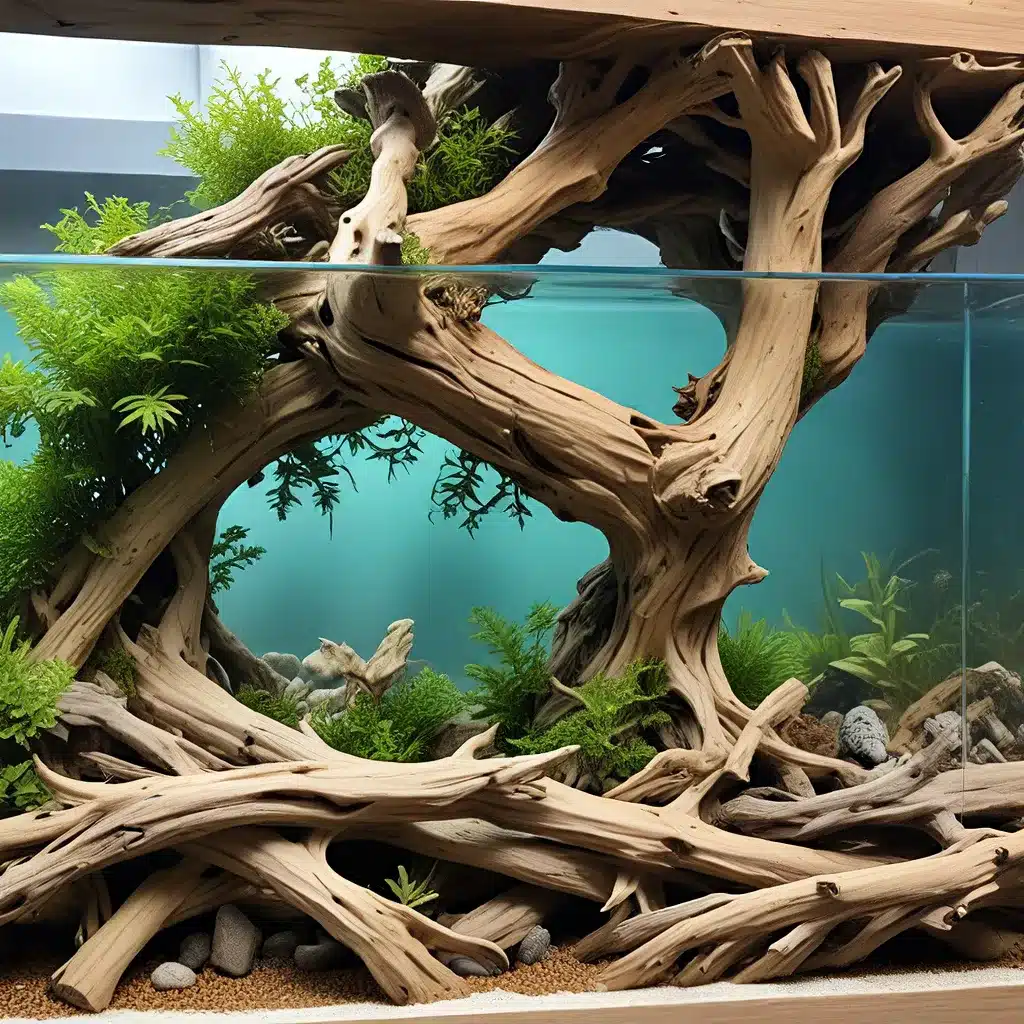
Harnessing the Power of Driftwood in Aquascaping
When it comes to aquarium design, the strategic placement of driftwood can unlock a world of untapped potential. Driftwood, with its unique shapes, textures, and organic appeal, has the remarkable ability to transform an ordinary aquarium into a captivating underwater landscape. In this comprehensive guide, we will explore the art of driftwood placement, delving into the nuances that can elevate your aquarium’s aesthetics and function.
Embracing the Diverse Qualities of Driftwood
Driftwood is a versatile and dynamic element in the aquarium hobby. Beyond its visual allure, driftwood offers a multitude of benefits that contribute to the overall health and well-being of your aquatic ecosystem. From providing shelter and breeding grounds for fish to serving as a platform for plant growth and the establishment of beneficial biofilms, driftwood is a true workhorse in the aquarium.
One of the key advantages of incorporating driftwood is its ability to influence water chemistry. King Aquarium experts explain that certain wood types, like oak and redwood, can release tannins into the water, creating a natural and desirable blackwater effect. This not only enhances the visual appeal of the aquarium but also mimics the conditions found in the natural habitats of many tropical fish species.
Moreover, the intricate textures and nooks of driftwood offer ample surface area for the growth of beneficial bacterial colonies and the formation of biofilms. These microbial communities play a crucial role in maintaining water quality and facilitating nutrient cycling within the aquarium ecosystem.
Strategizing Driftwood Placement
Successful driftwood placement in an aquarium requires a delicate balance of aesthetics and function. Begin by considering the overall layout and theme of your aquascape. How can the driftwood complement and enhance the existing design elements?
Tip: Experiment with different orientations and positions to create a visually captivating arrangement. Vertical, horizontal, or even angled placements can evoke a sense of depth and movement within the aquarium.
Functional Considerations:
– Ensure that the driftwood placement allows for adequate water flow and circulation, as this promotes oxygenation and the distribution of nutrients throughout the tank.
– Consider the positioning of the driftwood in relation to the substrate and other hardscaping elements, as this can create diverse microhabitats and hiding spots for your aquatic inhabitants.
– Strategically place driftwood to provide shelter, spawning areas, and foraging opportunities for your fish, shrimp, and other aquatic life.
Aesthetic Factors:
– Arrange the driftwood in a way that enhances the overall visual harmony of the aquascape, complementing the colors, textures, and shapes of the plants and other decor.
– Experiment with different groupings or clusters of driftwood to create a sense of depth and visual interest.
– Incorporate the driftwood placement as part of a larger aquascaping plan, ensuring it seamlessly integrates with the entire composition.
Preparing and Maintaining Driftwood
Before introducing driftwood into your aquarium, it’s crucial to properly prepare and condition the wood. This step helps to ensure the long-term stability and health of your aquatic ecosystem.
Preparation:
– Thoroughly clean the driftwood to remove any dirt, debris, or potential contaminants.
– Soak the driftwood in water for several days or weeks, allowing it to become fully waterlogged and sink to the bottom of the tank.
– Consider boiling the driftwood or treating it with a diluted hydrogen peroxide solution to sterilize it and remove any unwanted organisms.
Maintenance:
– Monitor the driftwood for any signs of deterioration, such as cracks, splits, or discoloration, and address them promptly.
– Regularly clean the driftwood’s surface to remove any accumulated algae, biofilms, or detritus, ensuring it maintains a healthy appearance.
– If the driftwood begins to release excessive tannins, causing the water to become too dark, consider removing it temporarily or reducing the amount of time it remains submerged.
Integrating Driftwood with Aquatic Life
The strategic placement of driftwood can have a profound impact on the behavior and well-being of your aquatic inhabitants. By understanding the specific needs and preferences of your fish, shrimp, and other aquatic life, you can create an environment that caters to their natural instincts and promotes their overall health.
Fish Habitat Preferences:
– Certain fish species, such as cichlids, catfish, and loaches, thrive in aquariums with ample driftwood, as it provides them with hiding spots, territorial boundaries, and spawning sites.
– Schooling fish, like tetras and rasboras, may feel more secure and exhibit natural schooling behaviors when driftwood is present, as it offers a sense of security and protection.
– Floating or suspended driftwood can create additional surface area for top-dwelling fish to rest and bask in the light.
Shrimp and Invertebrate Considerations:
– Driftwood can serve as an excellent breeding ground and foraging area for shrimp, as the biofilms and microorganisms that accumulate on the wood provide a valuable food source.
– The nooks and crannies of the driftwood offer ample hiding spots for small invertebrates, such as snails and freshwater crabs, helping them thrive in the aquarium environment.
Plant Integration:
– Driftwood can provide a sturdy and natural-looking platform for the attachment and growth of aquatic plants, including mosses, ferns, and epiphytic species.
– The positioning of driftwood can influence the overall layout and composition of the planted aquascape, creating visual interest and a sense of depth.
Embracing the Wonders of Driftwood
As you embark on your aquascaping journey, let the diverse qualities of driftwood inspire you to create captivating and functional underwater environments. By strategically incorporating driftwood into your aquarium, you can unlock a world of possibilities, from enhancing water chemistry and promoting beneficial microbial growth to providing essential habitat features for your aquatic inhabitants.
Remember, the art of driftwood placement is an ongoing process of experimentation, observation, and refinement. Embrace the dynamic nature of your aquarium and be open to adjusting the layout as your aquatic ecosystem evolves. With patience, creativity, and a deep appreciation for the natural world, you can transform your aquarium into a true underwater haven that captivates both you and your aquatic companions.

